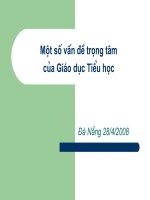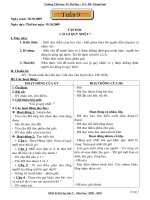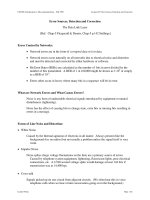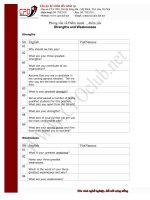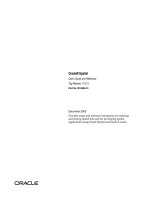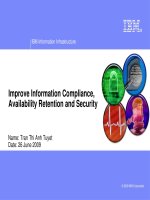Tài liệu lecture 09: Error Sources, Detection and Correction doc
Bạn đang xem bản rút gọn của tài liệu. Xem và tải ngay bản đầy đủ của tài liệu tại đây (43.37 KB, 6 trang )
CSN200 Introduction to Telecommunications, Fall 1999 Lecture-09 Error Sources, Detection and Correction
Error Sources, Detection and Correction
The Data Link Layer
[Ref: Chap-5 Fitzgerald & Dennis, Chap-5 p.142 Stallings]
Error Control In Networks:
• Network errors are in the form of corrupted data or lost data.
• Network errors occur naturally on all networks due to electrical noise and distortion
and must be detected and corrected by either hardware or software.
• Bit Error Rates (BERs) are calculated as the number of bits in error divided by the
number of bits transmitted. A BER of 1 in 100,000 might be shown as 1:10
5
or simply
as a BER of 10
-5
.
• Errors often occur in bursts where many bits in a sequence will be in error.
What are Network Errors and What Causes Errors?
Noise is any form of undesirable electrical signals introduced by equipment or natural
disturbances (lightening).
Noise has the effect of causing bits to change state, extra bits or missing bits resulting in
errors in a message.
Forms of Line Noise and Distortion:
• White Noise
Caused by the thermal agitation of electrons in all matter. Always present (like the
background hiss on radios) but not usually a problem unless the signal itself is very
weak.
• Impulse Noise
Noise spikes (large voltage fluctuations on the line) are a primary source of errors.
Caused by telephone system equipment, lightening, fluorescent lights, poor electrical
connections, etc. A 1/100 second voltage spike would damage at least 144 bits if
transmission was at 14,400 bps.
• Cross-talk
Signals picked up on one circuit from adjacent circuits. (We often hear this in voice
telephone calls when we hear a faint conversation going on in the background.)
lecture 09.doc Page 1 (6)
CSN200 Introduction to Telecommunications, Fall 1999 Lecture-09 Error Sources, Detection and Correction
• Intermodulation Noise
A special type of crosstalk. The signals from two circuits combine to form a new signal
that falls into a frequency band reserved for another signal. Similar to harmonics in
music.
• Echoes and Echo Suppression
Echo suppressers are used in the telephone system on long distance calls. Echoes are
caused by impedance mismatches in the telephone equipment. Modems automatically
disable echo suppressers so they can communicate in full duplex. Echoes can
sometimes be strong enough to cause data errors.
• Attenuation
Attenuation is the loss of power or signal strength as signals travel from a transmitting
device to a receiving device. Weaker signals are more subject to errors.
• Attenuation Distortion
Not all signal frequencies are attenuated the same amount; high frequencies are
attenuated more than low frequencies. This distortion can cause errors.
• Delay distortion
Distortion caused by the fact that different frequencies travel through the cable at slightly
different speeds.
• Jitter
Phase jitter refers to small fluctuations in the phase of a carrier signal. If some form of
phase modulation is being used by a modem (and most do) then this jitter will
incorrectly add to the natural phase shift used by the modem for sending different bit
patterns, resulting in errors.
• Harmonic distortion
Distortion introduced by amplifiers on a circuit.
• Line outages
Failure of a communication circuit for a brief period of time resulting in a major loss of
data. Caused by telephone system equipment failure or power outages.
lecture 09.doc Page 2 (6)
CSN200 Introduction to Telecommunications, Fall 1999 Lecture-09 Error Sources, Detection and Correction
Error Prevention:
• Shielding (p.140)
Covering a cable or equipment with a grounded metallic conductor shields it from
electrical noise, and prevents it from generating any noise as well.
• Moving Cables
Relocating cables away from sources of noise (like power cables, fluorescent lights, and
electrical machinery)
• Changing Multiplexing Techniques - changing frequencies or guard bands.
• Improving Connection Quality
• Amplifiers and Repeaters
Amplifiers are used on analog phone lines to overcome attenuation. Digital Repeaters are
used on digital phone lines. Repeaters and amplifiers placed closer together will
improve signal quality.
• Equalization
Equalizers are devices that compensate for attenuation and delay distortion. They can be
built into leased phone lines and are built into most modems to improve error rates.
• Conditioning
Leased private lines can be conditioned (at a cost) using many of the techniques
described above, to lower error rates.
Error Detection:
Error detection involves sending extra information with a message (frame, packet, block,
etc.) which is used by the receiver to determine whether the data has been received
correctly and is complete. Usually some type of calculation is performed on the data by
the transmitter. The receiver performs the same calculation on the received data and if
the two results are identical it assumes the data is correct.
Error Correction:
If the data has an error, a short message (NAK or Negative Acknowledgment) must be
sent back to the transmitter requesting that the entire message be retransmitted.
Forward Error Correction involves sending sufficient redundant information in the
original transmission that errors can be corrected at the receiver without requiring
retransmission.
lecture 09.doc Page 3 (6)
CSN200 Introduction to Telecommunications, Fall 1999 Lecture-09 Error Sources, Detection and Correction
Error Detection Methods:
• Parity Checking
The oldest, simplest and least effective method of error detection is parity checking. One
additional bit is added to each byte transmitted, based on even (total number of 1 bits
must be an even number) or odd (total number of 1 bits is an odd number) parity.
Even parity - total number of '1's must be an even number
Odd parity - total number of '1's must be an odd number
Detects single bit errors (or any odd number of errors) but cannot detect 2, 4 or 6 bits
(any even number of errors) in error. This results in a very poor error detection rate of
about 50%.
ASCII Parity
Odd Parity ‘D’ 1000100 1
Even Parity ‘D’ 1000100 0
Odd Parity ‘D’ 1000101 1 <== bit 0 damaged (Parity violation detected)
Odd Parity ‘D’ 1000111 1 <== bits 0 and 1 damaged (Parity violation NOT detected)
• LRC: Longitudinal Redundancy Checking
LRC adds an additional character, the Block Check Character (BCC) to the end of the
message or block of data. The BCC uses parity on each bit position for each character in
the message; in other words, by determining parity on the first bit of each character and
setting the first bit of the BCC to that value; then determining parity on the second bit of
each character, etc.
Has an improved error detection rate of more than 98%.
Letter ASCII Parity Bit
D 1000100 1
A 1000001 1
T 1010100 0
A 1000001 1
BCC 1101111 1
lecture 09.doc Page 4 (6)
CSN200 Introduction to Telecommunications, Fall 1999 Lecture-09 Error Sources, Detection and Correction
• Polynomial Checking
• Checksum
A checksum is calculated by adding up the decimal value of each character in the
message, dividing the sum by 255 and using the remainder as the checksum to be
transmitted with the message.
The receiver calculates its own checksum and compares it with the one sent. If they
are the same, it assumes there are no errors.
It is able to detect errors about 95% of the time. (Still not very good).
• CRC: Cyclic Redundancy Checking (Best Method **)
This method is used for most network error detection today. An 8, 16, 24 or 32 bit
number is added to the end of the data. Known as CRC-8, CRC-16, CRC-24 or CRC-
32 based on the number of bits used.
All of the data in the message is processed according to a mathematical algorithm (A
polynomial is divided by a prime number resulting in a quotient and a remainder.
Uses a "linear feedback shift register", normally implemented with hardware to
generate a unique 16 or 32 bit remainder based on the data that was sent. ) The
remainder is transmitted as the CRC code. The receiver processes the incoming data
using the same algorithm and then compares it’s CRC with the one transmitted. If
they are the same, the data must be correct.
• CRC-16 detects 99.99% errors; that is 1 in 10,000 errors goes undetected.
• CRC-32 is extremely proficient in detecting errors; approximately 1 in 10
14
errors
go undetected.
If transmitting at 9600 bps, 24 hours a day, 365 days a year, it would take 3000 years
for a single undetected error to occur.
Ethernet Local Area Networks use a 32-bit CRC code.
Error Correction via Retransmission:
Except for simple asynchronous transmission, most data is sent in frames or packets (Fig 5-12)
synchronously. When a packet is received with errors in it, some method must be established to
correct the error.
The simplest way of dealing with errors is to ask the sender to retransmit the original frame or
packet. This method is called ARQ (Automatic Repeat Request). Two variations of ARQ are:
• Stop and Wait ARQ (Fig 5-4)
• This is a very slow method, essentially a half-duplex communication method.
lecture 09.doc Page 5 (6)
